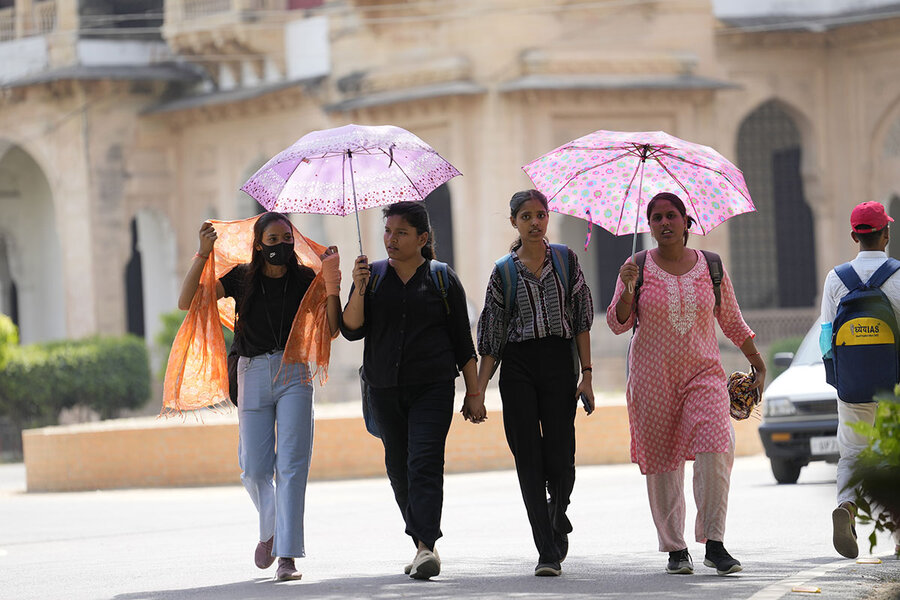‘Uncharted territory’: How Asia is coping with extreme heat
Loading...
| Manila, Philippines
Record-breaking heat waves continue to grip much of southern Asia. Thailand is now in its ninth week of intense heat, and Vietnam broke its national temperature record for a second time this month when a northern district clocked in at 111.6 degrees Fahrenheit. On May 12, the Philippines logged a heat index – what the temperature feels like combined with humidity – of 122 F in Legazpi City.
Last week, the World Meteorological Organization warned that human-induced climate change and the looming El Niño – a natural climate event that leads to a drier monsoon season – will likely “push global temperatures into uncharted territory.”
Why We Wrote This
A story focused onWhen it comes to beating rising heats, there’s no one-size-fits-all solution. Across Asia, communities are adapting to extreme temperatures, showcasing both human resilience and the far-reaching costs of climate change.
Experts say innovation and national climate plans will be critical in mitigating the long-term costs of extreme heat. But flexibility and common-sense solutions are helping keep communities afloat in the short term. From condensing school days to shifting office hours, people throughout Asia are making sacrifices in the name of safety. Peasant leader Ruben Salvador in the Philippines’ Isabela province says farmers in his community are already starting to swap rice for root vegetables, okra, and other drought-resistant crops.
“We need to plan ahead and diversify the farms,” he says. “We cannot just rely on emergency aid from the government. We must continue producing food, not for ourselves, but for the whole country.”
On a small vegetable farm in Lal-lo town in the northern Philippine province of Cagayan, Eduardo Pamittan starts his day before dawn. Since April, the middle-aged farmer has been trying to finish all his work between 4 a.m. and 10 a.m., before the late morning sun and humidity become “unbearable.”
“I have to wake up so early each day,” he says. “It is really unsafe to work under the unrelenting heat.”
And unrelenting it is, as record-breaking heat waves continue to grip much of southern Asia. On May 12, the Philippines logged a heat index – what the temperature feels like combined with humidity – of 122 degrees Fahrenheit in Legazpi City. Thailand is now in its ninth week of intense heat, and Vietnam broke its national temperature record for a second time this month when the northern district of Tuong Duong clocked in at 111.6 F.
Why We Wrote This
A story focused onWhen it comes to beating rising heats, there’s no one-size-fits-all solution. Across Asia, communities are adapting to extreme temperatures, showcasing both human resilience and the far-reaching costs of climate change.
Just last week, the World Meteorological Organization warned that human-induced climate change and the looming El Niño phenomenon – a natural climate event that leads to a drier monsoon season – will likely “push global temperatures into uncharted territory” and “have far-reaching repercussions for health, food security, water management and the environment.”
While innovation and national climate plans will be critical in mitigating the long-term costs of extreme heat, flexibility and common-sense solutions are helping keep communities afloat in the short term. From condensing school days to shifting work hours, people throughout Asia are making sacrifices in the name of safety. It doesn’t hurt, some experts note, that resilience is part of the region’s DNA.
Asian people “have been coping with heat for a very long time,” says Ronita Bardhan, associate professor of sustainable built environment at the University of Cambridge.
“We have cultural mechanisms in place,” she says, from the clothing people wear to the foods they eat in the summer to how homes are built.
The key to climate resilience, she adds, will be preserving that cultural knowledge and marrying it with modern technology. “It cannot be a copy and paste of what a Global North country is doing in order to combat the heat,” she says.
Lifestyle changes
Earlier this month in the Philippines, public elementary schools in Quezon City shortened class hours to allow students and teachers to avoid dangerous temperatures. Some kids attend school from 6 a.m. to 10:30 a.m., others from 2 p.m. to 6:30 p.m.
The initiative is in line with the education department’s order permitting public schools to change teaching modalities, including blended and modular distance learning, in the event of natural disasters, power interruptions, and other calamities.
“Our utmost priority will always be the welfare of our children,” says Joy Belmonte, mayor of Quezon City.
There are downsides. Rinaliza Alvarez, mother of a fourth grader who’s attended morning classes this past month, worried that “my daughter would only learn half of the lessons” with shortened hours. Still, she agrees that “adjustments should be made to ensure the protection of the children.”
In Siem Reap, Cambodia, which has regularly reached triple digits over the past month, humanitarian worker Joseph Josh Ajero decided to extend office hours instead of cutting back. Mr. Ajero, who drives a motorcycle to work, says he leaves home early in the morning, “when the sun is still touching the horizon,” and leaves the office “when the sky turns orange.”
It makes for long days, he says, but it’s not that bad a trade-off.
“The advantage of spending extended hours at the office is that I can finish many tasks,” he says.
Mercury is soaring in India as well, with several states struggling to manage earlier-than-average heat waves. Many in the country’s vast informal workforce have lost out on wages when it was too hot to work, and last month, 13 people died of heat stroke and many more were hospitalized during an outdoor political event in Mumbai.
“Poor and vulnerable communities in India are the most affected by these extreme weather events,” says local geographer and National Geographic Explorer Alisha Vasudev, who’s written about the relationship between urban heat and shrinking green spaces. “If we want the safety of the people, governments and nations must come up with effective development strategies.”
Making a plan
Indeed, experts agree that no lifestyle adjustment can replace sustainable development.
Researchers have linked these and other extreme heat events around the world to man-made global warming, particularly the burning of fossil fuels. Shortening school days and staying indoors during peak hours are surface-level solutions which often come with their own hidden costs.
Lourdes Tibig, climate science adviser for the Philippines-based Institute for Climate and Sustainable Cities, says that recent extreme heat underscores “the importance of incorporating climate change and resiliency into long-term development planning.”
“Ensuring that climate-smart infrastructures and services are available in schools and workplaces can help students and workers focus on their tasks while minimizing discomfort,” she explains.
But when it comes to building a framework for responding to unprecedented heat waves, Dr. Bardhan, the University of Cambridge professor, notes that countries need to strike a balance between national planning and local discretion. In the case of India, she says the government must “develop heat action plans which will allow communities to create their own local responses to combat extreme heat.”
National governments tend to respond in “a quick manner which overlooks a lot of interconnected and intersectional issues,” she adds.
One sector that’s feeling the burn is agriculture. These record-breaking temperatures are expected to impact Asia’s food chains long after the heat wave breaks.
It’s happened before – India was forced to ban wheat exports last year after persistent heats slashed the staple crop’s production by up to 25%. India’s Meteorological Department has warned the same could happen this year.
And in the Philippines, similar concerns about crop viability have farmers reconsidering what they plant, especially as they prepare for El Niño to begin in June.
Alfie Pulumbarit, the national coordinator of MASIPAG, a farmer-led sustainable agriculture network, expects farmers to veer away from crops that require high capital, such as hybrid rice varieties, and turn to native seeds, which regenerate each season and don’t require expensive fertilizers and pesticides. “The needs of the family and the community must come first,” he says.
Peasant leader Ruben Salvador in Isabela province, north of Manila, says farmers in his community are already starting to plant root vegetables, okra, eggplant, and other drought-resistant crops.
“Rice won’t survive without water,” says Mr. Salvador. “That’s why we need to plan ahead and diversify the farms. We cannot just rely on emergency aid from the government. We must continue producing food, not for ourselves, but for the whole country.”










